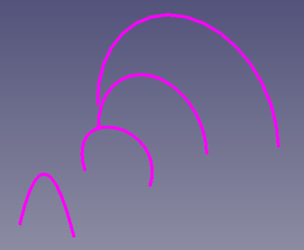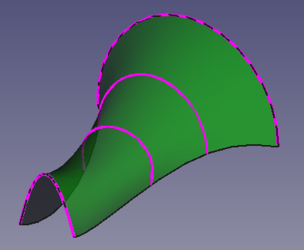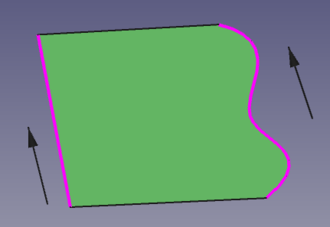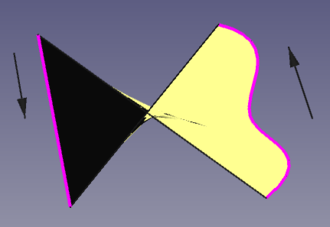|
|
| Posizione nel menu |
|---|
| Surface → Sections |
| Ambiente |
| Surface |
| Avvio veloce |
| Nessuno |
| Introdotto nella versione |
| 0.19 |
| Vedere anche |
| Nessuno |
Descrizione
Lo strumento Surface Sections viene utilizzato per creare una superficie dai bordi che rappresentano sezioni trasversali di una superficie.


A sinistra: i bordi di controllo (sezioni trasversali). A destra: la superficie prodotta da questi bordi.
Utilizzo
- Assicurarsii di avere almeno due bordi o curve nello spazio. Questi bordi possono essere creati con gli strumenti di
Draft o di
Sketcher.
- Premere il pulsante
Surface sections.
- Premere Add edge.
- Usare il puntatore per selezionare i bordi desiderati nella vista 3D; verrà visualizzata un'anteprima della forma finale dopo aver selezionato due bordi validi.
- Premere OK per completare l'operazione.
Opzioni
- Add edge: press once to start picking edges in the 3D view. Individual lines such as
Draft BSplines and
Sketcher BSplines can be chosen, as well as any edge from solid objects, like those of
PartDesign Bodies and
Part Primitives.
- Remove edge: press once to start picking edges in the 3D view; these must be edges that were previously picked with Add edge.
- Right mouse button: open the context menu and select Remove, or press Del in the keyboard, to remove the currently selected edge in the list.
- Drag: drag the currently selected element in the list in order to change the order in which it will be processed; the list is processed from top to bottom.
- Press Cancel or Esc to abort the current operation.
Proprietà
Una Surface Sections (classe Surface::Sections) è derivato dalla base Part Feature (classe Part::Feature, attraverso la sottoclasse Part::Spline), quindi condivide tutte le proprietà di quest'ultima.
Oltre alle proprietà descritte in Part Feature, Surface Sections ha le seguenti proprietà nell'editor delle proprietà.
Dati
Sections
- DatiNSections (
LinkSubList): un elenco di bordi che verranno utilizzati per costruire la curva.
Vista
Base
- VistaControl Points (
Bool): il valore predefinito èFALSE; se impostato suTRUE, mostrerà una sovrapposizione con i punti di controllo della superficie.
Twisting of the surface
The shape of the surface depends on the direction of the chosen edges; if edges are selected and the result is a surface that "twists" on itself, one of the edges may need its list of vertices in the reverse order. See the information in GeomFillSurface for a more complete explanation.


Script
Vedere anche: Script di base per FreeCAD
The Surface Sections tool can be used in macros and from the Python console by adding the Surface::Sections object.
- The edges to be used to define the surface must be assigned as a LinkSubList to the
NSectionsproperty of the object. - All objects with edges need to be computed before they can be used as input for the properties of the Sections object.
import FreeCAD as App
import Draft
doc = App.newDocument()
pl1 = App.Placement()
obj1 = Draft.make_circle(50, placement=pl1, face=False, startangle=0, endangle=180)
pl2 = App.Placement(App.Vector(0, 0, 25), App.Rotation())
obj2 = Draft.make_circle(30, placement=pl2, face=False, startangle=0, endangle=180)
points3 = [App.Vector(18, -10, 50),
App.Vector(12, 10, 50),
App.Vector(-12, 10, 50),
App.Vector(-18, -10, 50)]
obj3 = Draft.make_bspline(points3)
points4 = [App.Vector(15, -20, 100),
App.Vector(0, 6, 100),
App.Vector(-15, -20, 100)]
obj4 = Draft.make_bspline(points4)
doc.recompute()
surf = doc.addObject("Surface::Sections", "Surface")
surf.NSections = [(obj1, "Edge1"),
(obj2, "Edge1"),
(obj3, "Edge1"),
(obj4, "Edge1")]
doc.recompute()
Questa pagina è recuperata da https://wiki.freecad.org/Surface_Sections